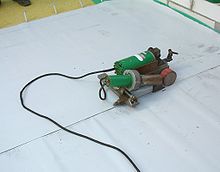Roof waterproofing
The roof waterproofing is the outermost layer of the roof membrane that protects the structure from the ingress of precipitation . In contrast to the roof covering , which diverts precipitation through a structural roof slope, the roof sealing is impermeable to water. Roof seals are mainly used on flat roofs , but also on pitched roofs that are additionally sealed.
Depending on the shape of the roof , roof pitch, weather conditions and planning regulations, different materials and processing methods are used.
It is attached to the substrate using:
- full or partial gluing or welding
- mechanical fastening
- Load such as gravel washed 16 to 32 mm in diameter or substrates for green roofs .
materials
- EPDM geomembrane according to EN 13956; ÖNORM B 3663, according to studies by the SKZ Süddeutsches Kunststoff-Zentrum over 50 years
- Bitumen sheeting
- Bitumen roofing membrane (V13 DIN 52143; ÖNORM B 3635, 3651ff - colloquially often referred to as roofing felt )
- Plastic roofing membranes made from plasticized polyvinyl chloride (PVC-P)
- Metal - usually sheets made of stainless steel that are joined by welding
- Liquid waterproofing - with multi-component waterproofing resins made from unsaturated polyester (UP), polyurethane (PUR) or polymethyl methacrylate (PMMA)
- Reinforced concrete - as a white tank (waterproof (waterproof) concrete is not sufficient)
- Loam - in areas with relatively little rainfall, often mixed with manure
literature
- ZVDH (editor): Technical rules for waterproofing - flat roof guidelines , Rudolf Müller, Cologne 2009
- Frick / Knöll / Neumann / Weinbrenner: Building construction theory , Teubner, Stuttgart 1988
Web links
Commons : Roofs - Collection of images, videos and audio files
- The safe roof , the safe roof
